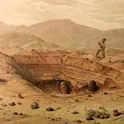
Humanities
09 Sep 2022
Scientific ‘detective work’ reveals South American mummies were brutally murdered
By Mischa Dijkstra, Frontiers science writer Sketch from the book by Reiss and Stübel (1887. The necropolis at Ancon) on the excavations and findings at the necropolis of Ancon, Peru. As it was typical at the end of the 19th/beginning of the 20th century, the content of graves was examined on the spot: mummy bundles and objects worth selling were taken away, invaluable items discarded. An international team used interdisciplinary techniques including 3D CT to do a ‘virtual autopsy’ on three mummies found in Peru and Chile, dating to between 900 and 1300 CE. They show that both male mummies had been murdered. These results highlight the wealth of archeological information that can be gained from mummies, as opposed to from skeletons. How frequent was violence in prehistoric human societies? One way to measure this is to look for trauma in prehistoric human remains. For example, a recent review of pre-Columbian remains found evidence of trauma from violence in 21% of males. So far, most studies of this kind focused on skulls and other parts of the skeleton, but a potentially richer source of information are mummies, with their preserved soft tissues. Now in a new study in Frontiers in […]













